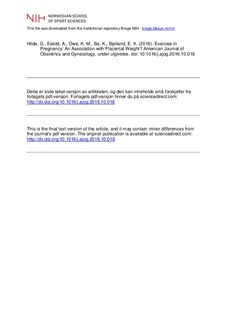| dc.contributor.author | Hilde, Gunvor | |
| dc.contributor.author | Esklid, Anne | |
| dc.contributor.author | Owe, Katrine Mari | |
| dc.contributor.author | Bø, Kari | |
| dc.contributor.author | Bjelland, Elisabeth K. | |
| dc.date.accessioned | 2017-01-24T10:25:49Z | |
| dc.date.available | 2017-01-24T10:25:49Z | |
| dc.date.issued | 2016-10-22 | |
| dc.identifier.citation | American Journal of Obstetrics and Gynecology. 2016. doi:http://dx.doi.org/10.1016/j.ajog.2016.10.018 | nb_NO |
| dc.identifier.uri | http://hdl.handle.net/11250/2428114 | |
| dc.description | I Brage finner du siste tekst-versjon av artikkelen, og den kan inneholde ubetydelige forskjeller fra forlagets pdf-versjon. Forlagets pdf-versjon finner du på http://www.sciencedirect.com/ In Brage you'll find the final text version of the article, and it may contain insignificant differences from the journal's pdf version. The definitive version is available at http://www.sciencedirect.com | nb_NO |
| dc.description.abstract | Background: Women with high levels of physical exercise have increased demand for oxygen and nutrients. Thus, in pregnancies of women with high levels of exercise it is conceivable that the supply of oxygen and nutrients to the placenta is sub-optimal, and growth could be impaired. Objective: To study the association of frequency of exercise during pregnancy with placental weight and placental to birthweight ratio. Study design: A prospective study of 80,515 singleton pregnancies in the Norwegian Mother and Child Cohort Study. Frequency of exercise was self-reported by a questionnaire at pregnancy weeks 17 and 30. Information on placental weight and birthweight was obtained by linkage to the Medical Birth Registry of Norway. Results: Placental weight decreased with increasing frequency of exercise (tests for trend, P<0.001). For non-exercisers in pregnancy week 17, crude mean placental weight was 686.1 g compared to 667.3 g in women exercising ≥ 6 times weekly (difference 18.8 g; 95% CI: 12.0 to 25.5). Likewise, in non-exercisers in pregnancy week 30, crude mean placental weight was 684.9 g compared to 661.6 g in women exercising ≥ 6 times weekly (difference 23.3 g; 95% CI: 14.9 to 31.6). The largest difference in crude mean placental weight were seen between non-exercisers at both time points and women exercising ≥ 6 times weekly at both time points (difference 31.7 g; 95% CI: 19.2 to 44.2). Frequency of exercise was not associated with placental to birthweight ratio. Conclusion: We found decreasing placental weight with increasing frequency of exercise in pregnancy. The difference in placental weight between non-exercisers and women with exercising ≥ 6 times weekly was small, and may have no clinical implications. | nb_NO |
| dc.language.iso | eng | nb_NO |
| dc.publisher | Elsevier | nb_NO |
| dc.subject | birthweight | nb_NO |
| dc.subject | exercise | nb_NO |
| dc.subject | Norwegian Mother and Child Cohort Study | nb_NO |
| dc.subject | placental weight | nb_NO |
| dc.subject | pregnancy | nb_NO |
| dc.title | Exercise in pregnancy: an association with placental weight | nb_NO |
| dc.type | Journal article | nb_NO |
| dc.type | Peer reviewed | nb_NO |
| dc.subject.nsi | VDP::Medisinske Fag: 700::Klinisk medisinske fag: 750 | nb_NO |
| dc.source.journal | American Journal of Obstetrics and Gynecology | nb_NO |
| dc.identifier.doi | http://dx.doi.org/10.1016/j.ajog.2016.10.018 | |
| dc.description.localcode | Seksjon for idrettsmedisinske fag / Department of Sports Medicine | nb_NO |
